1. Veiligheidsvoorzorgsmaatregelen
1.1. Algemene veiligheidsmaatregelen
Belangrijk
Lees deze handleiding zorgvuldig. Deze bevat belangrijke instructie die opgevolgd moeten worden tijdens installatie, gebruik en onderhoud.
Bewaar deze instructies voor verdere verwijzing rond bediening en onderhoud.
Waarschuwing
Explosiegevaar van de accu door vonken
Gevaar voor elektrische schokken
Installeer het product in een hittebestendige omgeving. Zorg er daarom voor dat er geen chemicaliën, plastic onderdelen, gordijnen of ander textielproducten enz. in de onmiddellijke nabijheid van de apparatuur aanwezig zijn.
Het product mag niet worden gemonteerd in een voor de gebruiker toegankelijke ruimte.
Zorg ervoor dat de apparatuur wordt gebruikt onder de juiste gebruiksomstandigheden. Gebruik het nooit in een vochtige omgeving.
Gebruik het product nooit op plaatsen waar gas- of stofexplosies kunnen optreden.
Zorg ervoor dat er altijd voldoende vrije ruimte rond het product is voor ventilatie.
Raadpleeg de specificaties van de fabrikant van de accu om ervoor te zorgen dat de accu geschikt is voor gebruik met dit product. De veiligheidsinstructies van de fabrikant van de accu moeten altijd in acht worden genomen.
Bescherm de zonnemodules gedurende de installatie tegen invallend licht, bijvoorbeeld door ze te bedekken.
Raak nooit open kabeluiteinden aan.
Gebruik alleen geïsoleerde gereedschappen.
Dit product is ontworpen en getest in overeenstemming met internationale normen. De apparatuur mag alleen voor de aangewezen toepassing worden gebruikt.
Aansluitingen moeten altijd gemaakt worden in de volgorde beschreven in het Installatie-hoofdstuk van deze handleiding.
De installateur van het product moet zorgen voor een trekontlasting op de kabel om de overdracht van spanning op de verbindingen te voorkomen.
In aanvulling op deze handleiding moet de systeembedienings of servicehandleiding een accu-onderhoudshandleiding omvatten die van toepassing is op het gebruikte type accu's.
1.2. Bedradingsveiligheidsmaatregelen
Let op
Gebruik flexibele meerdradige koperen kabel voor de accu- en PV-aansluitingen.
De diameter van de individuele draden van de kabel zouden niet groter moeten zijn dan 0,4 mm (0,016 inch) of een oppervlak groter dan 0,125 mm² (AWG26) moeten hebben.
De maximale bedrijfstemperatuur is 90 °C (194 °F).
Een kabel van 25 mm² moet bijvoorbeeld minimaal 196 draden hebben (klasse 5 of hoger volgens VDE 0295, IEC 60228 en BS6360). Een AWG2 kabel zou op zijn minst 259/26 draden moeten hebben (259 draden van AWG26). Voorbeeld van geschikte kabel: klasse 5 “Tri-rated”-kabel (met drie goedkeuringen: Amerikaans (UL), Canadees (CSA) en Brits (BS)).
In het geval van dikkere draden zal het contactoppervlak te klein zijn en zal de hoge contactweerstand ernstige oververhitting veroorzaken en uiteindelijk resulteren in brand. Zie onderstaand figuur voor voorbeelden van welke kabel wel en niet gebruikt moet worden.
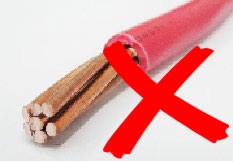 | 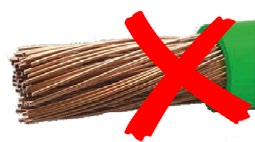 | 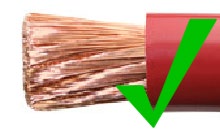 |
1.3. Symbolen gebruikt op de behuizing
De volgende symbolen worden gebruikt op de behuizing van de PV-lader:
Symbool | Naam | Betekenis |
|---|---|---|
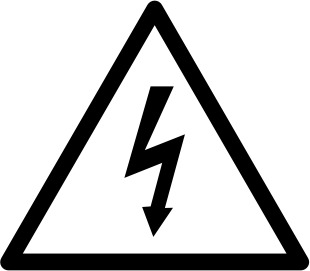 | Waarschuwing gevaar voor elektrische schokken | Raak de elektrische aansluitingen niet aan, er bestaat gevaar voor elektrische schokken. |
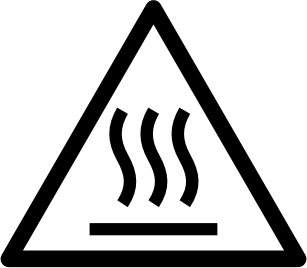 | Waarschuwing heet oppervlak | Raak het oppervlak van het apparaat niet aan, terwijl het in bedrijf is wordt het heet. |
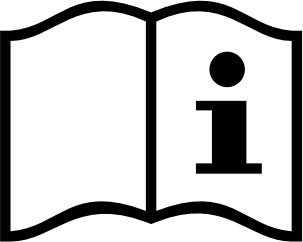 | Lees de handleiding | Lees de producthandleiding vóór installatie en gebruik. |
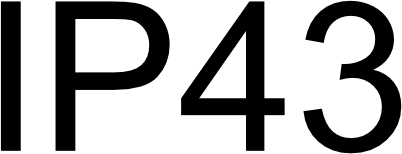 | Beschermingswaarde tegen binnendringen | IP43 - De elektronische componenten zijn beschermd tegen gereedschap en kleine draden groter dan 1 millimeter en beschermd tegen waternevel onder een hoek van minder dan 60 graden ten opzichte van de verticaal. |
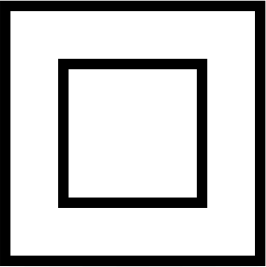 | Dubbel isolatie-symbool | Het apparaat is dubbel geïsoleerd en vereist geen veiligheidsaansluiting naar elektrische aarding (aarding). |
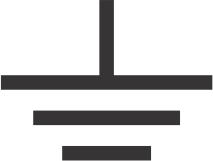 | Aardingssymbool | Geeft de plaats aan van de aardingsaansluitklem. |
 | Aardingssymbool | Geeft de plaats aan van de apparaat aarding. |
1.4. SmartSolar MPPT 150/35 FCC and Industry Canada Compliance
This device complies with part 15 of the FCC Rules and to RSS of Industry Canada.
Operation is subject to the following two conditions:
This device may not cause harmful interference, and
This device must accept any interference received, including interference that may cause undesired operation.
Le présent appareil est conforme aux CNR d'Industrie Canada applicables aux appareils radio exempts de licence. L'exploitation est autorisée aux deux conditions suivantes : (1) l’appareil ne doit pas produire de brouillage, et (2) l’utilisateur de l’appareil doit accepter tout brouillage radioélectrique subi, même si le brouillage est susceptible d’en compromettre le fonctionnement.
Warning
Changes or modifications not expressly approved by the party responsible for compliance could void the user’s authority to operate the equipment.
Note: This equipment has been tested and found to comply with the limits for a Class A digital device, pursuant to part 15 of the FCC Rules. These limits are designed to provide reasonable protection against harmful interference in a commercial environment. This equipment generates, uses and can radiate radio frequency energy and, if not installed and used in accordance with the instructions, may cause harmful interference to radio communications. However, there is no guarantee that interference will not occur in a particular installation. Operation of this equipment in a residential area may cause radio interference, in which case the user may be required to take adequate measures. If this equipment does cause harmful interference to radio or television reception, which can be determined by turning the equipment off and on, the user is encouraged to try to correct the interference by one or more of the following measures:
Reorient or relocate the receiving antenna.
Increase the separation between the equipment and receiver.
Connect the equipment into an outlet on a circuit different from that to which the receiver is connected.
Consult the dealer or an experienced radio/TV technician for help.
This Class A digital apparatus complies with Canadian ICES-003.
Cet appareil numérique de Classe A est conforme à la norme Canadienne ICES-003.
This device contains a transmitter with FCC ID: SH6MDBT42Q.
This device contains a transmitter with IC: 8017A-MDBT42Q.
To comply with FCC and Industry Canada RF radiation exposure limits for general population, the antenna(s) used for this transmitter must be installed such that a minimum separation distance of 20cm is maintained between the radiator (antenna) and all persons at all times and must not be co-located or operating in conjunction with any other antenna or transmitter.
1.5. SmartSolar MPPT 150/45 FCC and Industry Canada Compliance
This device complies with part 15 of the FCC Rules and to RSS of Industry Canada.
Operation is subject to the following two conditions:
This device may not cause harmful interference, and
This device must accept any interference received, including interference that may cause undesired operation.
Le présent appareil est conforme aux CNR d'Industrie Canada applicables aux appareils radio exempts de licence. L'exploitation est autorisée aux deux conditions suivantes : (1) l’appareil ne doit pas produire de brouillage, et (2) l’utilisateur de l’appareil doit accepter tout brouillage radioélectrique subi, même si le brouillage est susceptible d’en compromettre le fonctionnement.
Warning
Changes or modifications not expressly approved by the party responsible for compliance could void the user’s authority to operate the equipment.
Note: This equipment has been tested and found to comply with the limits for a Class B digital device, pursuant to part 15 of the FCC Rules. These limits are designed to provide reasonable protection against harmful interference in a residential installation. This equipment generates, uses and can radiate radio frequency energy and, if not installed and used in accordance with the instructions, may cause harmful interference to radio communications. However, there is no guarantee that interference will not occur in a particular installation. If this equipment does cause harmful interference to radio or television reception, which can be determined by turning the equipment off and on, the user is encouraged to try to correct the interference by one or more of the following measures:
Reorient or relocate the receiving antenna.
Increase the separation between the equipment and receiver.
Connect the equipment into an outlet on a circuit different from that to which the receiver is connected.
Consult the dealer or an experienced radio/TV technician for help.
This Class B digital apparatus complies with Canadian ICES-003.
Cet appareil numérique de Classe B est conforme à la norme Canadienne ICES-003.
This device contains a transmitter with FCC ID: SH6MDBT42Q.
This device contains a transmitter with IC: 8017A-MDBT42Q.
To comply with FCC and Industry Canada RF radiation exposure limits for general population, the antenna(s) used for this transmitter must be installed such that a minimum separation distance of 20cm is maintained between the radiator (antenna) and all persons at all times and must not be co-located or operating in conjunction with any other antenna or transmitter.